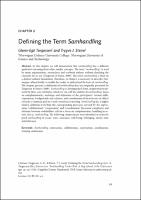Chapter 2 Defining the Term Samhandling
| dc.contributor.author | Torgersen, Glenn-Egil | |
| dc.contributor.author | Steiro, Trygve | |
| dc.date.accessioned | 2018-10-08 11:23:21 | |
| dc.date.accessioned | 2020-04-01T12:20:32Z | |
| dc.date.available | 2020-04-01T12:20:32Z | |
| dc.date.issued | 2018 | |
| dc.identifier | 1001643 | |
| dc.identifier | OCN: 1076650655 | en_US |
| dc.identifier.uri | http://library.oapen.org/handle/20.500.12657/28319 | |
| dc.description.abstract | "In this chapter we will demonstrate that samhandling has a different qualitative meaning from other similar concepts. The term “samhandling” is used by many organizations, researchers and textbook authors without clarifying the rationale for its use (Torgersen & Steiro, 2009). The word samhandling is built on a distinct cultural foundation. Therefore, we think it is necessary to describe Norwegian culture briefly, to enable the reader to understand the basis of samhandling. The chapter presents a definition of samhandling that was originally presented by Torgersen & Steiro (2009). Samhandling is distinguished from cooperation/teamwork by three core attributes which we can call the identity of samhandling: focus on complementarity, exchange and utilization of the participants’ various skills, experiences, backgrounds and cultures, and coordination of these factors in efforts towards a common goal in a work situation or meeting. Samhandling has a higher relative ambition level than the corresponding processes covered by the expressions “collaboration”, “cooperation” and “coordination”. Increased complexity and relations between stakeholders call for a focus on complementary handling in action, that is, samhandling. The following competencies were identified in order for good samhandling to occur: trust, assurance, well-being, belonging, clarity, time and tolerance." | |
| dc.language | English | |
| dc.subject.classification | thema EDItEUR::J Society and Social Sciences | en_US |
| dc.subject.classification | thema EDItEUR::J Society and Social Sciences::JW Warfare and defence | en_US |
| dc.subject.classification | thema EDItEUR::J Society and Social Sciences::JW Warfare and defence::JWK Military and defence strategy | en_US |
| dc.subject.other | Samhandling | * |
| dc.subject.other | interaction | * |
| dc.subject.other | collaboration | * |
| dc.subject.other | cooperation | * |
| dc.subject.other | coordination | * |
| dc.subject.other | training | * |
| dc.subject.other | unforeseen | * |
| dc.subject.other | Textbook | * |
| dc.title | Chapter 2 Defining the Term Samhandling | |
| dc.type | chapter | |
| oapen.identifier.doi | 10.23865/noasp.36.ch2 | |
| oapen.relation.isPublishedBy | bf7b42a4-6892-42e3-aaf8-8f32c8470a8b | |
| oapen.relation.isPartOfBook | 2724fb8b-60f0-4a89-9f93-98ba00ad6223 | |
| oapen.pages | 16 | |
| oapen.place.publication | Oslo | |
| oapen.identifier.ocn | 1076650655 |

